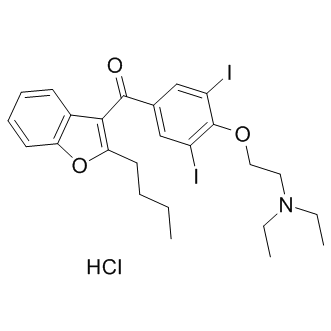| Description: |
Amiodarone is an antiarrhythmic drug for inhibition of ATP-sensitive potassium channel with IC50 of 19.1 μM.in vitro: It was found that 10 uM amiodarone induces accumulation of ethidium bromide (5 ug/ml) in Saccharomyces cerevisiae cells. At the same time, in yeast cells with inactivated MDR genes, accumulation of ethidium bromide was 6-fold higher even without amiodarone. Addition of non-lethal concentrations of amiodarone to MDR-deficient cells caused an increase of intracellular ethidium bromide to the level, which was even lower than the level in amiodarone-treated wild-type cells. Cells treated with amiodarone were seen to have detached from the dish, with cell rounding, cytoplasmic blebbing and irregularity in shape. An increase in the sub-G1 phase fraction, from 15.43 to 21.34% and 79.83% and a reduction in the G1 phase fraction, from 48.83 to 41.63% and 11.52%, were observed in cells treated with amiodarone at concentrations of 0.1 and 1 mM, respectively.
in vivo: Chronic treatment with oral amiodarone for 4 weeks reduced i.p. when myocytes were dialyzed with patch-pipettes containing either 10 mM Na+ or 80 mM Na+. In myocytes from untreated rabbits, acute exposure to amiodarone in vitro reduced i.p. when patch pipettes contained 10 mM Na+ but had no effect on i.p. at 80 mM Na+. Amiodarone had no effect on the voltage dependence of the pump or the affinity of the pump for extracellular K+ either after chronic treatment or during acute exposure. |






















